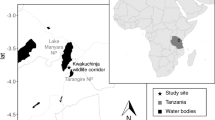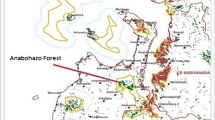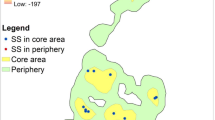Abstract
Selection of sleeping sites has consequences for individual fitness. Non-human primates often bias their selection towards arboreal sites, and the lemurs of Madagascar typically rest/sleep in trees, tree holes, and/or constructed nests. Three non-mutually exclusive hypotheses to explain sleeping site selection include protection from predators, avoidance of parasitic vectors, and improved thermoregulation. Here, we examine these hypotheses for the unusual sleeping site selections by the southern bamboo lemur (Hapalemur meridionalis). Within the Mandena littoral forest of southeast Madagascar, the southern bamboo lemur is known for its ecological flexibility compared to other bamboo lemur species, including a dietary niche expansion to feeding on the ground. Between October 2012 and December 2013, we observed bamboo lemurs from three social groups for 1778.67 h, conducting full-day focal follows on 11 adult individuals (five males, six females). During this period, all three groups were observed to sleep on the ground, with one of these groups also using an abandoned nest of a Madagascar crested ibis (Lophotibis cristata). We collected habitat and temperature data to examine whether selection was influenced by environmental variables. Terrestrial sleeping (N = 17) was observed in all individuals but one adult female, with individuals burrowing under thick vegetation more often during the hot austral summer. While difficult to rigorously test, it is possible that terrestrial sleep sites and/or sleeping in a bird nest may impair visual detection by some aerial and terrestrial predators. Neither of these sites (i.e., terrestrial sleeping or use of a bird nest), however, is likely to minimize exposure to parasites/vectors. Terrestrial sleeping appears to support a thermoregulatory strategy, whereas the use of a bird nest could not be empirically tested. Our observations of unique sleeping site locations used by southern bamboo lemurs further the complexity of their natural history and that of Malagasy strepsirrhines.

Similar content being viewed by others
References
Anderson JR (1998) Sleep, sleeping sites, and sleep-related activities: awakening to their significance. Am J Primatol 46:63–75
Anderson JR (2000) Sleep-related behavioural adaptations in free-ranging anthropoid primates. Sleep Med Rev 4:355–373
Anderson JR, McGrew WC (1984) Guinea baboons (Papio papio) at a sleeping site. Am J Primatol 6:1–14
Baden AL, Wright PC, Louis EE Jr, Bradley BJ (2013) Communal nesting, kinship, and maternal success in a social primate. Behav Ecol Sociobiol 67:1939–1950
Blanco MB, Dausmann KH, Ranaivoarisoa JF, Yoder AD (2013) Underground hibernation in a primate. Sci Rep 3:1768
Cheyne SM, Höing A, Rinear J, Sheeran LK (2012) Sleeping site selection by agile gibbons: the influence of tree stability, fruit availability and predation risk. Folia Primatol 83:299–311
Cowlishaw G (1994) Vulnerability to predation in baboon populations. Behaviour 131:293–304
Csermely D (1996) Antipredator behavior in lemurs: evidence of an extinct eagle on Madagascar or something else? Int J Primatol 17:349–354
Dausmann KH, Glos J (2015) No energetic benefits from sociality in tropical hibernation. Funct Ecol 29:498–505
Dausmann KH, Glos J, Ganzhorn JU, Heldmaier G (2004) Physiology: hibernation in a tropical primate. Nature 429:825–826
Dewar RE, Richard AF (2007) Evolution in the hypervariable environment of Madagascar. Proc Natl Acad Sci 104:13723–13727
Donati G, Ramanamanjato JB, Ravoahangy AM, Vincelette M (2007) Translocation as a conservation measure for a threatened species: the case of Eulemur collaris in the Mandena littoral forest, south-eastern Madagascar. In: Ganzhorn JU, Goodman SM, Vincelette M (eds) Biodiversity, ecology, and conservation of the littoral ecosystems in southeastern Madagascar, Tolagnaro (Fort Dauphin). Smithsonian Institution Press, Washington, DC, pp 237–243
Eppley TM, Ravelomanantsoa R (2015) Predation of an adult southern bamboo lemur Hapalemur meridionalis by a Dumeril’s boa Acrantophis dumerili. Lemur News 19:2–3
Eppley TM, Verjans E, Donati G (2011) Coping with low-quality diets: a first account of the feeding ecology of the southern gentle lemur, Hapalemur meridionalis, in the Mandena littoral forest, southeast Madagascar. Primates 52:7–13
Eppley TM, Donati G, Ramanamanjato J-B, Randriatafika F, Andriamandimbiarisoa LN, Rabehevitra D, Ravelomanantsoa R, Ganzhorn JU (2015a) The use of an invasive species habitat by a small folivorous primate: implications for conservation. PLoS One 10:e0140981
Eppley TM, Hall K, Donati G, Ganzhorn JU (2015b) An unusual case of affiliative association of a female Lemur catta in a Hapalemur meridionalis social group. Behaviour 152:1041–1061
Eppley TM, Ganzhorn JU, Donati G (2015c) Cathemerality in a small, folivorous primate: proximate control of diel activity in Hapalemur meridionalis. Behav Ecol Sociobiol 69:991–1002
Eppley TM, Ganzhorn JU, Donati G (2016) Latrine behaviour as a multimodal communicatory signal station in wild lemurs: the case of Hapalemur meridionalis. Anim Behav 111:57–67
Fruth B, Hohmann G (1993) Ecological and behavioral aspects of nest building in wild bonobos (Pan paniscus). Ethology 94:113–126
Fruth B, Hohmann G (1996) Nest building behavior in the great apes: The great leap forward? In: McGrew WC, Marchant LF, Nishida T (eds) Great ape societies. Cambridge University Press, Cambridge, pp 225–240
Goodman SM, O’Connor S, Langrand O (1993) A review of predation on lemurs: implications for the evolution of social behavior in small nocturnal primates. In: Kappeler PM, Ganzhorn JU (eds) Lemur social systems and their ecological basis. Plenum Press, New York, pp 51–66
Heymann EW (1995) Sleeping habits of tamarins, Saguinus mystax and Saguinus fuscicollis (Mammalia; Primates; Callitrichidae), in north-eastern Peru. J Zool 237:211–226
Kappeler PM (1998) Nests, tree holes, and the evolution of primate life histories. Am J Primatol 46:7–33
Kappeler PM, Cremer S, Nunn CL (2015) Sociality and health: impacts of sociality on disease susceptibility and transmission in animal and human societies. Philos T R Soc B 370:20140116
Karpanty SM (2006) Direct and indirect impacts of raptor predation on lemurs in southeastern Madagascar. Int J Primatol 27:239–261
Koops K, Humle T, Sterck EHM, Matsuzawa T (2007) Ground-nesting by the chimpanzees of the Nimba Mountains, Guinea: environmentally or socially determined? Am J Primatol 69:407–419
Koops K, McGrew WC, de Vries H, Matsuzawa T (2012) Nest-building by chimpanzees (Pan troglodytes verus) at Seringbara, Nimba Mountains: antipredation, thermoregulation, and antivector hypotheses. Int J Primatol 33:356–380
Loudon JE, Sauther ML (2013) Verreaux’s sifaka (Propithecus verreauxi) and ring-tailed lemur (Lemur catta) endoparasitism at the Bezà Mahafaly special reserve. Madag Conserv Dev 8:21–28
Lutermann H, Verburgt L, Rendigs A (2010) Resting and nesting in a small mammal: sleeping sites as a limiting resource for female grey mouse lemurs. Anim Behav 79:1211–1219
McGrew WC (2004) The cultured chimpanzee: reflections on cultural primatology. Cambridge University Press, Cambridge
Morland HS (1990) Parental behavior and infant development in ruffed lemurs (Varecia variegata) in a northeast Madagascar rain forest. Am J Primatol 20:253–265
Nakagawa N (1999) Differential habitat utilization by patas monkeys (Erythrocebus patas) and tantalus monkeys (Cercopithecus aethiops tantalus) living sympatrically in northern Cameroon. Am J Primatol 49:243–264
Perret M (1998) Energetic advantage of nest-sharing in a solitary primate, the lesser mouse lemur (Microcebus murinus). J Mammal 79:1093–1102
Pruetz JD (2007) Evidence of cave use by savanna chimpanzees (Pan troglodytes verus) at Fongoli, Senegal: implications for thermoregulatory behavior. Int J Primatol 48:316–319
Pruetz JD, Fulton SJ, Marchant LF, McGrew WC, Schiel M, Waller M (2008) Arboreal nesting as anti-predator adaptation by savanna chimpanzees (Pan troglodytes verus) in southeastern Senegal. Am J Primatol 70:393–401
Samson DR, Muehlenbein MP, Hunt KD (2013) Do chimpanzees (Pan troglodytes schweinfurthii) exhibit sleep related behaviors that minimize exposure to parasitic arthropods? A preliminary report on the possible anti-vector function of chimpanzee sleeping platforms. Primates 54:73–80
Sauther ML, Cuozzo FP, Jacky IY, Fish KD, LaFleur M, Ravelohasindrazana LA, Ravoavy JF (2013) Limestone cliff-face and cave use by wild ring-tailed lemurs (Lemur catta) in southwestern Madagascar. Madag Conserv Dev 8:73–80
Savage AF, Robert V, Goodman SM, Raharimanga V, Raherilalao MJ, Andrianarimisa A, Ariey F, Greiner EC (2009) Blood parasites in birds from Madagascar. J Wildlife Dis 45:907–920
Schülke O, Ostner J (2000) Predation on Lepilemur by a harrier hawk and implications for sleeping site quality. Lemur News 6:5
Stewart FA (2011) Brief communication: why sleep in a nest? Empirical testing of the function of simple shelters made by wild chimpanzees. Am J Phys Anthropol 146:313–318
Stewart FA, Pruetz JD (2013) Do chimpanzee nests serve an anti-predatory function? Am J Primatol 75:593–604
Tan CL (2006) Behavior and ecology of gentle lemurs (genus Hapalemur). In: Gould L, Sauther ML (eds) Lemurs: ecology and adaptation. Springer, New York, pp 369–381
Tecot SR, Baden AL, Romine NK, Kamilar JM (2012) Infant parking and nesting, not allomaternal care, influence Malagasy primate life histories. Behav Ecol Sociobiol 66:1375–1386
Thorén S, Quietzsch F, Radespiel U (2010) Leaf nest use and construction in the golden-brown mouse lemur (Microcebus ravelobensis) in the Ankarafantsika National Park. Am J Primatol 72:48–55
Treves A (2002) Predicting predation risk for foraging, arboreal monkeys. In: Miller LE (ed) Eat or be eaten: predator sensitive foraging among primates. Cambridge University Press, Cambridge, pp 222–241
Videan EN (2006) Sleep in captive chimpanzee (Pan troglodytes): the effects of individual and environmental factors on sleep duration and quality. Behav Brain Res 169:187–192
Wright PC (1999) Lemur traits and Madagascar ecology: coping with an island environment. Yearb Phys Anthropol 42:31–72
Yamagiwa J (2001) Factors influencing the formation of ground nests by eastern lowland gorillas in Kahuzi-Biega National Park: some evolutionary implications of nesting behavior. J Hum Evol 40:99–109
Zohdy S, Kemp AD, Durden LA, Wright PC, Jernvall J (2012) Mapping the social network: tracking lice in a wild primate (Microcebus rufus) population to infer social contacts and vector potential. BMC Ecol 12:4
Acknowledgments
We thank the Direction du Système des Aires Protégées, and the Ministère de l’Environnement et Forêts of Madagascar for permission to conduct research. Special thanks to Jacques Rakotondranary and Tolona Andrianasolo, for their logistical assistance, and to Katie Hall for assistance in the field. We also thank the Environment Team at QIT Madagascar Minerals (QMM) for their assistance and provision of logistical support onsite, and acknowledge their helpful staff, especially Jean-Baptiste Ramanamanjato, Johny Rabenantoandro, Faly Randriatafika, Laza Andriamandimbiarisoa, David Rabehevitra, and Robertin Ravelomanantsoa. This field research was result of generous financial and in-kind support provided by the American Society of Primatologists, Conservation International’s Primate Action Fund, Idea Wild, Mohamed bin Zayed Species Conservation Fund (project number: 11253008), Primate Conservation Inc., and the Primate Society of Great Britain/Knowsley Safari Park.
Author information
Authors and Affiliations
Corresponding author
Ethics declarations
Ethical approval
This study was conducted under the Accord de Collaboration between the University of Antananarivo, the University of Hamburg, and QMM. Research protocols were approved by all institutions and permits authorized by the Commission Tripartite of the Direction des Eaux et Forêts de Madagascar (Autorisation de recherché n.240/12/MEF/SG/DGF/DCB.SAP/SCB du 17/09/2012), adhering to the legal requirements of Madagascar.
About this article
Cite this article
Eppley, T.M., Donati, G. & Ganzhorn, J.U. Unusual sleeping site selection by southern bamboo lemurs. Primates 57, 167–173 (2016). https://doi.org/10.1007/s10329-016-0516-4
Received:
Accepted:
Published:
Issue Date:
DOI: https://doi.org/10.1007/s10329-016-0516-4




